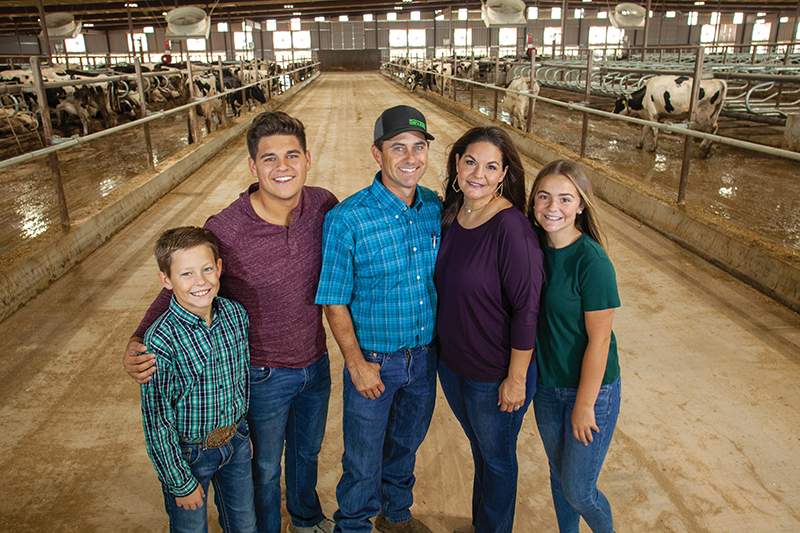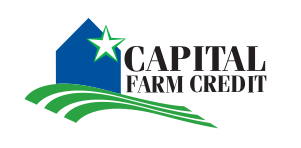News
Milking the most of it

This West Texas dairy farm embraces robotic technology to improve the family operation.
Spend 10 minutes with T&K Dairy owner Will Collier and you quickly get the picture. Life on a dairy farm is busy. Even when the days are long, time is short.“Milking cows for a living is all about efficiency,” says Will. “You have to be efficient, or you won’t last very long.”
That’s why Will and his wife, Lauren, decided to invest in a robotic milking system. And with the help of Capital Farm Credit, the Colliers were able to turn their 10-year vision into a reality.
Building a sustainable operation
Located along the dusty edge of Texas’ South Plains near Snyder, the Colliers’ dairy is a third-generation operation. T&K Dairy was started in 1982 by Will’s father and grandfather, Tim and Keith.“I grew up on the dairy farm and loved it,” says Will. “It’s hard work, and there’s always something to do. I like the challenge.”
On the Collier farm, you’ll find more than 3,000 dairy cows — Holsteins, Jerseys and crossbreds. There are also hundreds of calves waiting their turn. All of T&K’s milk cows are homegrown. And because Will likes staying busy, you’ll find several hundred Angus beef cows and nearly 150 show pigs too. That’s in addition to a farming operation that includes thousands of acres of row crops — cotton, corn, sorghum and wheat.
“Everything works together here,” says Will. “We grow feed for the cows and convert their waste into fertilizer for the crops. We also recycle the water used in our dairy barns three times. You could call us sustainable. We try to be good stewards of the land.”
Reaching a crossroads in the business
Dairy farmers are often among the first to adopt new technology. Perhaps it’s their commitment to efficiency. For the Colliers, technology and milk management go hand in hand.“Several years ago, we made the move to SCR monitoring collars,” says Will. “These gave us insight into everything from rumination to reproduction. They’ve helped us better manage herd health and productivity.”
While the smart collars made it easier to manage the herd from a distance, milking cows three times a day still required significant labor. Then, a few years ago, the Colliers hit a critical decision point. They had to quickly determine the future course of their dairy operation.
“We found out we needed to replace our older barn,” says Lauren. “It had major structural issues. I knew Will always wanted a carousel parlor. But that type barn still requires several people to work with the cows. And it’s so hard to find quality labor. No one wants to milk cows 12 hours a day anymore. I told Will that we ought to look into robots.”
The Colliers were introduced to robotic milking systems 10 years ago at a Dairy Farmers of America meeting. Back then, they were interested in robots, but wanted to wait and let the technology work out the kinks. By 2018, they were ready to take the next step.
Working with a familiar face
“I knew it was time,” says Will. “We’d been thinking about robots for a while. This was a chance to improve our operation and make the dairy life more appealing for the next generation.”Will purchased T&K Dairy in 2008 from his father with the help of Capital Farm Credit. A decade later, it made sense to work with the lender who already knew his business. This was especially true since he planned to introduce the first full robotic milking system to the state of Texas.
“I called Capital,” says Will. “I’ve been working with them since we started. They know agriculture, and they offer flexible lending options. They understand us.”
Tommy Henderson, branch manager at Capital’s Snyder branch, has known the Colliers for a long time.
“We all went to high school together. Will and I were in FFA,” says Henderson. “He’s been around dairy his whole life. He knows what he is doing.”
Due to the scope of the project, Henderson brought in Bryce Jordan to help. Jordan is one of Capital’s relationship managers for commercial ag, specializing in dairy.
“As a family operator with a strong track record, T&K is an ideal customer,” says Jordan. “When I met with Will, he had done his due diligence, and he had a plan. Will knew how the robots could improve his operations and help them become even more efficient producers of milk.
“Will is a smart guy. I have a lot of respect for how he runs the business,” Jordan adds.
Introducing robots to the cows
The new barn and robotic milking system were unveiled in August 2019. It didn’t take long for the cows to acclimate. As an incentive to entering a milk stall, the cows receive a delicious treat.“The cows really like the new system. It uses lasers to line-up and attach the milking cups. Everything is very gentle,” says Will. “Once in the stall, the cows are fed pellets, which are like candy to them. The cows sometimes exit the stall and rush to get back in line again. They want more of those pellets!”
But the technology is smart. The system evaluates each cow to assess milk availability and overall health. If a cow doesn’t have enough milk, she is released without a pellet reward.
For those that get milked, the system quickly determines milk volume by udder quadrant and estimates the amount of milk to be extracted. Then pellets are dispensed based on a nutrition calculation.
The system is self-paced and low stress, which enhances productivity.
“The cows in our old barn on the traditional milking system are milked three times per day. But those in the new barn can get milked as often as they want,” says Will. “It averages out to 2.7 times per day across the herd, with some cows milking up to five times a day.”
The robots keep the milking operation moving quickly.
“Most cows are in and out in just a few minutes. The robots are very efficient, and we’ve found that the cows getting milked by the robots are producing more,” says Will.
Enhancing herd lifestyle
The barn also has a variety of creature comforts designed to increase cow health and well-being while improving milk production.“Dairy cows go into heat stress when the temperature gets above 75 degrees,” says Will. “In the new barn, we’re able to keep the cows very comfortable.”
The new barn includes a misting system and tunnel ventilation to keep temperatures near optimal. There are also water beds for the cows to rest on. The pens even have back scratchers that look like they were borrowed from the local carwash. And the cows line up for these too.
Another benefit of the new technology is the amount of data that can be monitored on each cow.
“Using my phone, I can check in anytime and monitor milk production, nutrition and animal health,” says Will. “The robotic system is even smart enough that it’ll sort the animals who have an issue like mastitis. The robot funnels those cows into a separate pen so they can be evaluated by our vet.”
Living a dairy good life
As part of a dairy co-op, T&K sends four tanker trucks of milk to be processed every day. This keeps the Collier family and T&K Dairy’s 32 employees busy.“Will works long days. Typically 10–12 hours,” says Lauren. “But he loves it.”
And at T&K, it’s a full family affair. Lauren manages the books and finances, and the couple’s three school-age children work for the family business in their spare time.
“Raising a family on a farm is a great way of life,” says Will. “Our kids contribute to the operation and understand how to work hard.
“Who knows? One of them may eventually want to take over. You have to be passionate about dairy. Otherwise the work is too hard. It’s been a great way of life for us.”
Lauren agrees.
“If we weren’t dairy farmers,” she says, “I don’t know who we’d be.”
